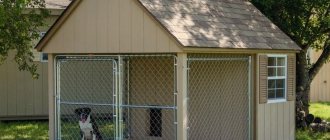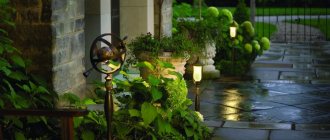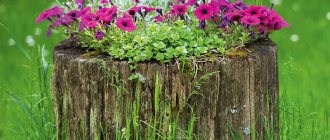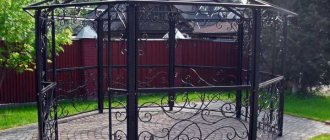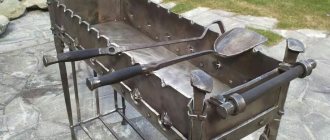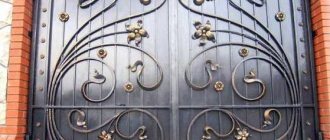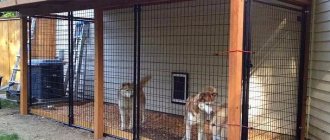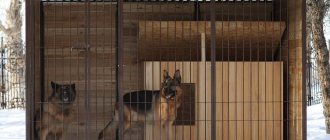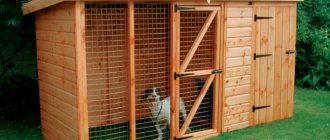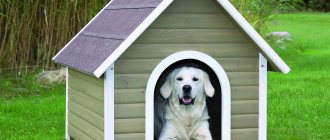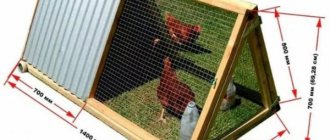Homemade
Enclosures are installed in the apartment if required:
- temporarily demarcate the territory when a newborn or a family member unfamiliar to the dog appears (if he is distrustful of strangers), another dog, or a cat;
- create a safe space for a puppy or several;
- give the dog a personal corner if for some reason there is not enough “space”: the dog, for psychological reasons, needs a fenced space, is not trained enough and, in the absence of its owners, spoils things, shows aggression towards family members.
Typically, an apartment enclosure is a lightweight prefabricated structure in the form of a fence. Often its role is played by a cell.
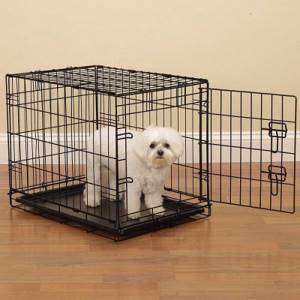
On the street
An outdoor enclosure is installed for both permanent and temporary (seasonal) residence of dogs of large and medium-sized long-haired breeds. Permanent buildings are made completely, with poured floors, solid walls, and the possibility of heating in winter.
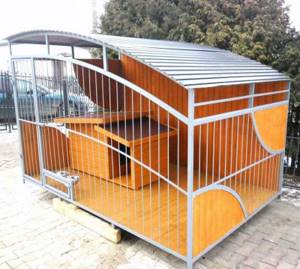
The summer option for a dacha can be collapsible - sometimes a metal mesh fence is enough.
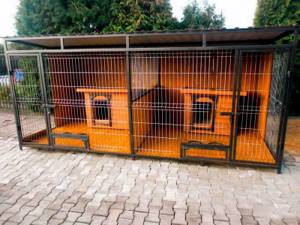
Here, the capitality of the construction depends on the temperament and breed qualities of the animal: in order to prevent a harmless but violent “calf” from trampling the beds, a clearly lighter structure will be required than for a large aggressive dog capable of jumping over, breaking through or digging through a fence.
Types of dog enclosures
Before starting construction, decide on the type and configuration of the future enclosure, and decide what the structure of your dog’s house will be. The appearance features will depend on a number of parameters: the materials you have chosen; breed, size and age of the pet, as well as your personal preferences for organizing a home for your pet.
The following types of enclosures are distinguished:
1. Temporary enclosures
– predominantly open structures. Designed for temporary housing of dogs, made in the form of a fence or mesh barrier. A booth is installed inside or a deck is made as a place to rest. This type of enclosure does not require a roof, since the pet does not stay in it for long.

2. Closed structures
- classified as intermediate structures. A booth or flooring must be installed inside. Since the dog stays in it for a long time, this enclosure must be insulated. Some walls can be made solid, but there must be at least one lattice side so that the animal can observe the situation.
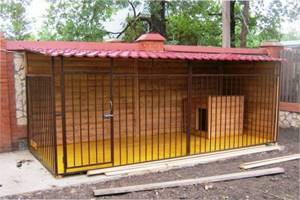
3. Capital enclosures
– have a structure separated from the lattice part in which a booth or other sleeping place is located. This structure is insulated on all sides, since the animal lives in it all year round. The lattice part of the building is used for walking and feeding. In harsh winter conditions, the feeding area can also be moved to the insulated part of the enclosure.
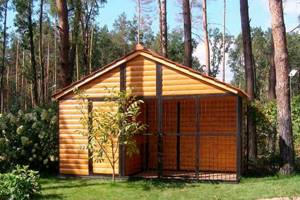
Breed
Capacity is planned according to the size of the pet. Keeping them in close quarters is unacceptable; dogs experience physical and psychological discomfort. Correspondence between animal growth and minimum construction area:
- 60-65 cm at the withers - from 10 m2;
- 50-60 cm - from 8 m2;
- less than 50 cm - from 6 m2.
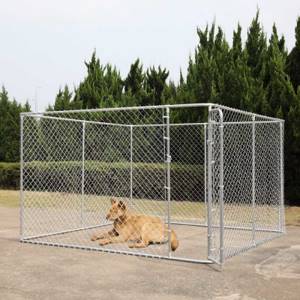
The inherent temperament of the breed and the individual is also taken into account. A large but calm dog (mastiff, Newfoundland) needs 12 m2, and a temperamental “perpetual motion machine” staff or husky needs at least 15. For short- and smooth-haired breeds, you will need an insulated shelter for the winter.
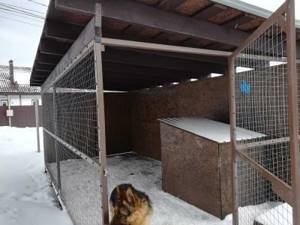
Types of forged enclosures
Enclosures with walking are an excellent solution. The dog will receive all the conditions for free movement and will be able to frolic and run without leaving the fenced area. This is the best option for owners of large animals, which due to the characteristics of the breed have a complex character.
- Standard models - they have a fixed size, wooden floor and roof, lattice walls. A dog house is definitely included. This purchase is relevant for a summer cottage if the pet is small in size.
- Individual products. These are exclusive models created in strict accordance with the wishes of customers. Additional options may be included - viewing sections that protect from precipitation, a feeding window, special insulation, and so on.
The masters of the Alois forge will offer you photos of typical projects and will assist you in selecting the optimal option suitable for a particular dog. We can also quickly produce a forged enclosure for you according to an individual sketch provided by you or developed by our designer in accordance with your wishes. Together we will create a cozy and most comfortable home for your pet.
Projects
How to make an enclosure that is useful for the dog and the owners? Define the task. What kind of design is required:
- summer - with a fence, space for walking, a special canopy for protection from precipitation and a resting place (it can be combined with a wooden canopy or a summer booth);
- year-round - in addition to the walking area, a winter house or booth with insulation (2-4 m2) is required;
- “dormitory” - if the dogs are not at odds, the walking area is common, otherwise it will have to be demarcated. Each dog has an individual house;
- The “maternity hospital + nursery” is equipped to meet the needs of the puppy and then the bitch who gave birth; space is provided for raising puppies.
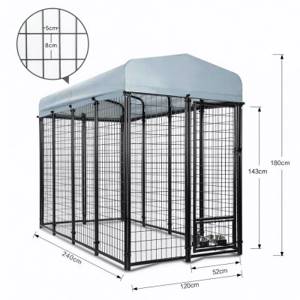
Types of enclosures
Before asking yourself the question of how to make an enclosure for a dog with your own hands, you need to decide exactly what kind of structure the owner wants to see in his yard.
Aviaries can be:
- Capital ones, which have walls, one of which must be mesh. The rest are insulated, as are the roof and decking. Inside there is a place to rest and a booth is located.
- Temporary buildings are mainly of an open type. The territory is simply enclosed with a net or fence. The decking and canopy are missing, but the booth is being installed.
- Closed enclosures can be called an intermediate option, where there are lattice walls, a booth and flooring. This type of home is considered partially insulated.
Depending on how much space can be allocated for the construction of an enclosure, its size is calculated. The size of the building should match the breed of your pet.
The size of the enclosure can be:
The area of the enclosure should provide free movement of the four-legged friend. Therefore, for a dog with a size at the withers of less than 50 cm, an enclosure with an area of 6 m2 will be sufficient. Larger animals with a height of 50-65 cm will need 8 m2 of free space, but large dogs (over 65 cm) should live in an enclosure with an area of 10 m2.
When keeping two or more pets, the enclosure increases by one and a half times, and it is even better to expand the construction over an area twice as large.
To allow the dog to move freely, one side of the building should not be shorter than two meters. Of course, this is not enough for a full life, so regular day and night walks cannot be excluded from your pet’s regimen.
Main elements of the building
What should the enclosure be made of so that it meets the necessary requirements? What building materials are optimal?
Base and floor
To create a columnar or monolithic strip foundation, a cement-sand mixture is usually used and the base is reinforced with reinforcement.
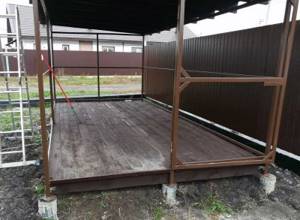
Then the concrete floor is poured - but it needs a top coat to prevent the concrete from harming the animals' joints and claws.
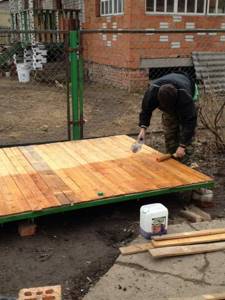
The wooden floor made of sanded boards is treated with a fire retardant and impregnated against mold and mildew, and covered with a layer of varnish, non-toxic to animals, to protect the wood from moisture.
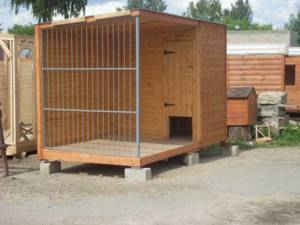
Roof
Optimal use of soft roofing:
- roofing felt;
- rolled membranes;
- flexible tiles.

Hard types of roofing will “sound” when it rains, irritating the animal’s auditory receptors and unnerving it.
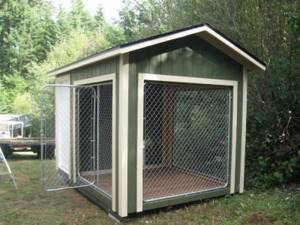
Basic requirements for the finished structure
In any photo of a dog’s enclosure, made correctly, it is noticeable that the dog feels calm and confident in it: it is not damaged by the teeth and claws of an animal experiencing stress.
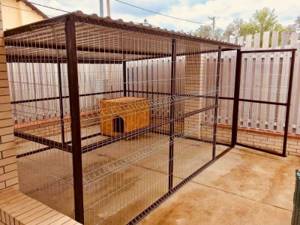
To ensure comfort for both animals and owners, the enclosure must be:
- safe - without sharp and “torn” surfaces, cracks, all elements should be securely fastened so that the tenant does not destroy his home and is not injured;
- reliable - made from building materials that are resistant to mechanical stress and the influence of climatic conditions;
- convenient for maintenance - cleaning and maintenance;
- equipped with all the important elements for animal living;
- zoned if necessary.
Sizes of enclosures depending on breed
When building or purchasing an enclosure for a dog here https://zooventa.ru/catalog/volery-kletki/, you should always remember that this is not just a place where he will be for the next few months, this is now his home, where he should to be habitually warm, dry, cozy and pleasant. Therefore, the layout and size should be approached extremely responsibly. This information will help you figure out what parameters an enclosure should have for a particular dog.
- Medium breeds, less than 50 cm at the withers, enclosure area not less than 6 square meters. m.
- The breed is slightly above average, 65-70 cm at the withers, enclosure area from 8 square meters. m.
- Tall breeds, more than 70 cm at the withers, enclosure area from 10 sq. m.
- The height of the enclosure for any of these breeds is 2 - 2.5 m.
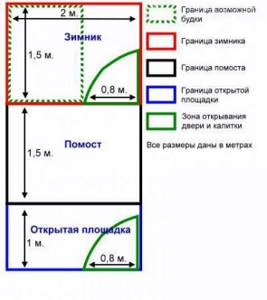
Construction stages
The aviary is built according to the following algorithm:
- Create a foundation (significant deepening is not necessary).
- Mount the frame.
- Make the floor. For concrete, formwork is made and concrete is poured. When it hardens, cover it with flooring. If a wooden floor is planned, first it is made rough (from a board 0.5 cm thick), then the top covering is laid.
- Make walls. Fasten the selected material to the frame.
- To mount the roof - first, a rafter supporting structure is created from timber, waterproofing and insulation materials are mounted on top, then the external protective coating is laid.
- Assess the type of enclosure and the conditions in which the dog is kept: it may be necessary to install drains, install wiring or install a heating system.
- Lastly, install the door.
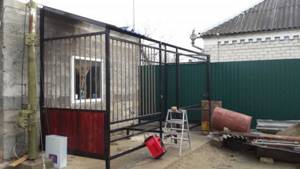
DIY dog enclosure - photo
We have prepared for you a huge number of interesting and successful solutions for building an enclosure. Try to make your dog feel comfortable and comfortable, do not forget about the basic needs of your pet, his leisure time and instincts. Your pet will be very grateful to you for this. Enjoy watching!
A dog is man's friend. A familiar phrase that is filled with deep meaning. Many owners of country houses or summer cottages first of all think about the healthy and comfortable maintenance of their four-legged pet. Nature provides for a dog to have its own personal territory or its own place to live. Alas, it is very difficult to create such conditions in modern apartments. Therefore, keeping pets in enclosures has become very popular recently. After all, an enclosure for a dog is a place where it feels like ownership and does not worry that someone can harm it.
Interior
The minimum set of dog “interior elements” includes:
- a booth or house that serves as a shelter and place of rest - the presence of such a structure at the dog’s permanent place of residence is mandatory to ensure his peace of mind. After all, in the apartment they set up a place for the animal where no one will disturb it - in an outdoor enclosure it is at a greater distance from the owner, feels less confident, so it needs shelter;
- bowls for food and water are mobile so that you can fill them and wash them, but they can be placed on a stationary stand so that the dog does not rattle them while chasing them around the “house”;
- straw or fabric bed, special mattress.
Types and photos
Manufacturers offer several types of forged enclosures. The designs of each category differ in configuration, dimensions, and cost.
Standard
Standard (classic) wrought-iron enclosures have a simple design consisting of lattice walls. Forged elements are not used for additional decoration. The dimensions of such structures do not exceed 2 by 3 meters . The floor, roof and booth are made of wood .
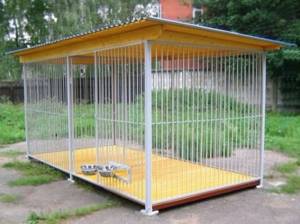
Forged aviary of the classical type. Kurdalagon Photos
Non-standard
Non-standard enclosure designs are implemented according to the client's individual order . The dimensions of the structure and the availability of free space are determined based on the characteristics of the breed and temperament of a particular animal.
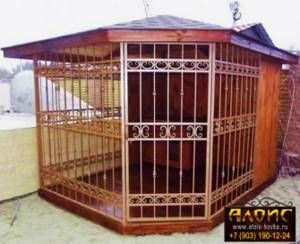
Forged aviary of a non-standard type. Photo Alois
At the request of the customer, the structures can be insulated, equipped with windows for feeding food, stands for bowls, wood panels that provide protection from weather influences, and decorated with elements of various shapes.
Large, with walking
Forged enclosures with a walking area allow the animal to move freely, do not cause a feeling of cramping and limited space, and provide space for running and playing. Large structures like these are suitable for keeping large breed dogs.
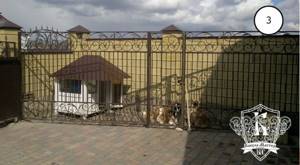
Wrought iron enclosure with walking space. Photo Vakula Master
In the form of a house
An interesting solution from a design point of view is a forged enclosure, made in the form of a house, with a gable roof . These structures are an excellent addition to any landscape.
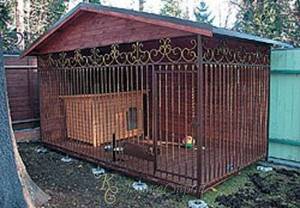
Wrought iron enclosure with a gable roof. Photo ForgingStroy
Free-standing and adjacent to the house
Most aviary models are free-standing structures. Such structures are attached to the asphalt or ground, and are also equipped with legs. In addition, there are structures designed to be located near the wall of a house, a fence, or as an extension to a building for utility or other purposes.
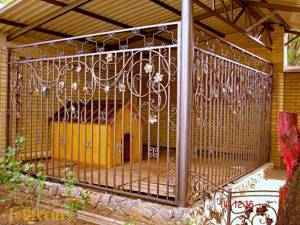
A wrought-iron enclosure located near a brick fence. Hephaestus Photos
Indoor, semi-indoor and open
Depending on the type of construction, there are three types of enclosures:
- indoor structures have a roof and are suitable for permanent housing of animals;
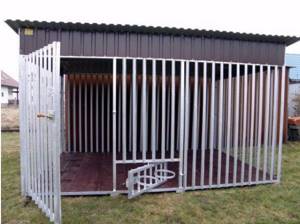
Forged indoor aviary. Photo Servo
- open enclosures are not equipped with a roof and are intended for temporary housing; this type should include playpens (fences) for puppies and kittens;
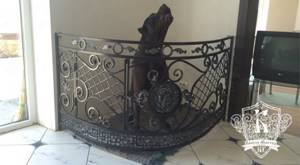
Forged enclosure-playpen. Photo Vakula Master
- partially open, have a roof over the area where the booth is located, the rest of the area is open air.
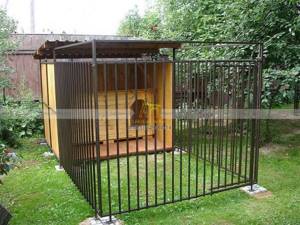
The wrought iron enclosure is partially open. Hotiron Photos
Features for puppies, small and large breed dogs
When purchasing or making your own enclosure, there are several components to consider. To keep puppies and dogs of miniature breeds, you should choose indoor or outdoor enclosures of small dimensions, as well as playpen structures.
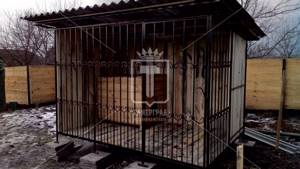
Wrought iron enclosure for miniature breed dogs. Timergrad Photos
For dogs of large breeds, as well as animals with increased activity, it is recommended to select spacious enclosures located on the street.
Regardless of the type of structure and breed of animal kept in the enclosure, a bowl of water and food, soft bedding, a tray, and toys should be marked inside.
Cold and hot forging
An important criterion for the classification of forged enclosures is the technology in accordance with which the structure is manufactured. The cold forging method produces structures characterized by a standard design, the absence or minimal level of decorative elements, and a relatively affordable cost. Using the hand-hot forging technique, unique projects are created that are implemented to individual orders and at a high price.
How to insulate an enclosure
For the winter period, it is necessary to insulate the enclosure - usually this means insulating the shelter. Using mineral wool is unprofitable - if the dog destroys the insulating layer, it will lose its usefulness and may harm his health.
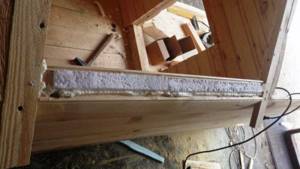
Glass wool should absolutely not be used! The best insulation materials are:
- Styrofoam;
- felt;
- rolled heat insulators.
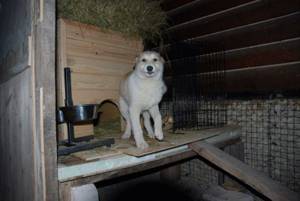
It is allowed to heat the booth using:
- panel heater mounted on the wall or roof of the booth;
- film type heater;
- warm floor.
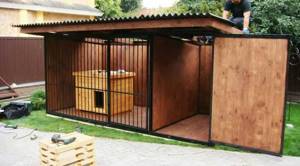
You can design and build a dog enclosure yourself or order it from craftsmen who are professionally involved in construction and repair. In the second case, building the structure will take less time, although it will require expenses.

Requirements for enclosures
If you decide to build an enclosure for your dog yourself, you should take into account a number of requirements that apply to such buildings. If you adhere to these principles, your pet will be comfortable and safe living in such a house. Many dog breeders have wondered about the comfort and safety of their pets and have come up with the following rules for organizing enclosures:
Aviary size
Not surprisingly, one of the main factors when designing a dog's future home is its size. From many sources it was possible to identify the following standards for the area of an enclosure:
- if the height of your dog at the withers is from 45 to 60 cm, then the area should be at least 6 m2; - from 50 to 60 cm at the withers - from 8 m2; - over 60 cm - the area of the enclosure must exceed 10 m2.
It is worth noting that saving space can lead to negative consequences for both the physical and psychological health of your pet. But you shouldn’t allocate too much space either, since in winter the enclosure must still maintain the air temperature.
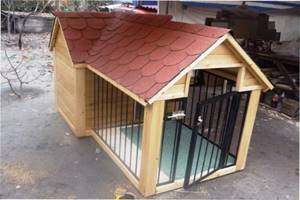
Aviary floor
Perhaps the most difficult question when constructing this building. It causes controversy even among experts. Many people prefer to line the floor with one material, often different types of wood. Others refer to the need to leave uncovered areas of land, since it is much more familiar and comfortable for a pet to relieve its natural needs on the soil.
In fact, the truth lies in the purpose of the enclosure. If your dog will be in it almost all the time, then the best solution will still be a combination of a wooden floor and an open area. If you are using an enclosure for temporary housing or wintering, but for a certain part of the day the animal quietly moves around the yard, then the floor can be completely covered with wood. Also consider the character of your four-legged friend, because some dogs can tear up the ground and escape from the enclosure.
